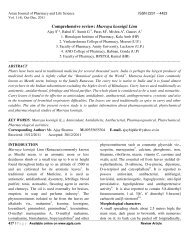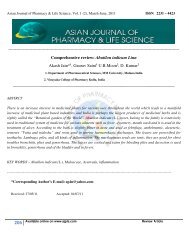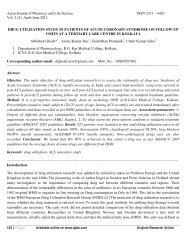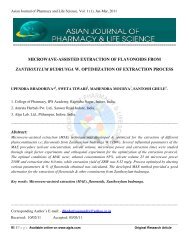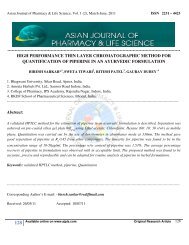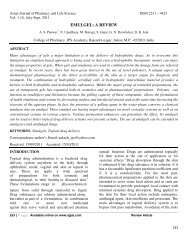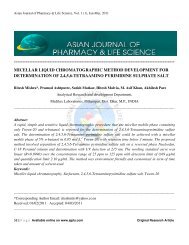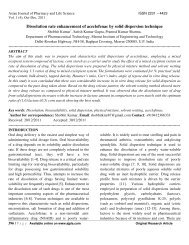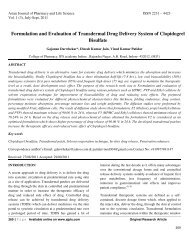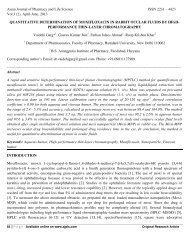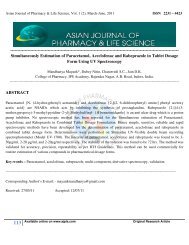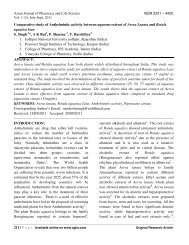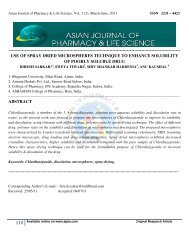Bioremediation - Asian Journal of Pharmacy and Life Science
Bioremediation - Asian Journal of Pharmacy and Life Science
Bioremediation - Asian Journal of Pharmacy and Life Science
You also want an ePaper? Increase the reach of your titles
YUMPU automatically turns print PDFs into web optimized ePapers that Google loves.
<strong>Asian</strong> <strong>Journal</strong> <strong>of</strong> <strong>Pharmacy</strong> <strong>and</strong> <strong>Life</strong> <strong>Science</strong> ISSN 2231 – 4423Vol. 2 (2), April-June,2012BioventingBioventing is a promising new technology that stimulates the natural in-situ biodegradation <strong>of</strong> any aerobicallydegradablecompounds in NAPL within the soil by providing oxygen to existing soil microorganisms. In contrast tosoil-vapor extraction (SVE), bioventing uses low air-flow rates to provide only enough oxygen to sustain microbialactivity. Oxygen is most commonly supplied through direct air injection into residual contamination in soil by means<strong>of</strong> wells. Adsorbed fuel residuals are biodegraded, <strong>and</strong> volatile compounds also are biodegraded as vapors moveslowly through biologically active soil.[5]BioaugmentationBioaugmentation is the introduction <strong>of</strong> a group <strong>of</strong> natural microbial strains or a genetically engineered variant to treatcontaminated soil or water. It is commonly used in municipal wastewater treatment to restart activated sludgebioreactors. Most cultures available contain a research based consortium <strong>of</strong> Microbial cultures, containing allnecessary microorganisms At sites where soil <strong>and</strong> groundwater are contaminated with chlorinated ethenes, such astetrachloroethylene <strong>and</strong> trichloroethylene, bioaugmentation is used to ensure that the in situ microorganisms cancompletely degrade these contaminants to ethylene <strong>and</strong> chloride, which are non-toxic[6] Monitoring <strong>of</strong> this system isdifficultBiopilingBiopile treatment is a full-scale technology in which excavated soils are mixed with soil amendments, placed on atreatment area, <strong>and</strong> bioremediated using forced aeration. The contaminants are reduced to carbon dioxide <strong>and</strong> water.The basic biopile system includes a treatment bed, an aeration system, an irrigation/nutrient system <strong>and</strong> a leach atecollection system. Moisture, heat, nutrients, oxygen, <strong>and</strong> pH are controlled to enhance biodegradation. Theirrigation/nutrient system is buried under the soil to pass air <strong>and</strong> nutrients either by vacuum or positive pressure. Soilpiles can be up to 20 feet high <strong>and</strong> may be covered with plastic to control run<strong>of</strong>f, evaporation <strong>and</strong> volatilization, <strong>and</strong>to promote solar heating. If volatile organic compounds (VOCs) in the soil volatilize into the air stream, the airleaving the soil may be treated to remove or destroy the VOCs before they are discharged into the atmosphere.Treatment time is typically 3 to 6 months [7]Ex-Situ <strong>Bioremediation</strong>Composting is a process by which organic wastes are degraded by microorganisms, typically at elevatedtemperatures.Typical compost temperatures are in the range <strong>of</strong> 55° to 65° C. The increased temperatures result fromheat produced by microorganisms during the degradation <strong>of</strong> the organic material in the waste. Windrow compostinghas been demonstrated using the following basic steps. First, contaminated soils are excavated <strong>and</strong> screened toremove large rocks <strong>and</strong> debris [8,9]BioreactorsSlurry reactors or aqueous reactors are used for ex situ treatment <strong>of</strong> contaminated soil <strong>and</strong> water pumped up from acontaminated plume. <strong>Bioremediation</strong> in reactors involves the processing <strong>of</strong> contaminated solid material (soil,sediment, sludge) or water through an engineered containment system. A slurry bioreactor may be defined as acontainment vessel <strong>and</strong> apparatus used to create a three-phase (solid, liquid, <strong>and</strong> gas) mixing condition to increase thebioremediation rate <strong>of</strong> soil bound <strong>and</strong> water-soluble pollutants as a water slurry <strong>of</strong> the contaminated soil <strong>and</strong> biomass206 | P a g e Available online on www.ajpls.com Review Article



